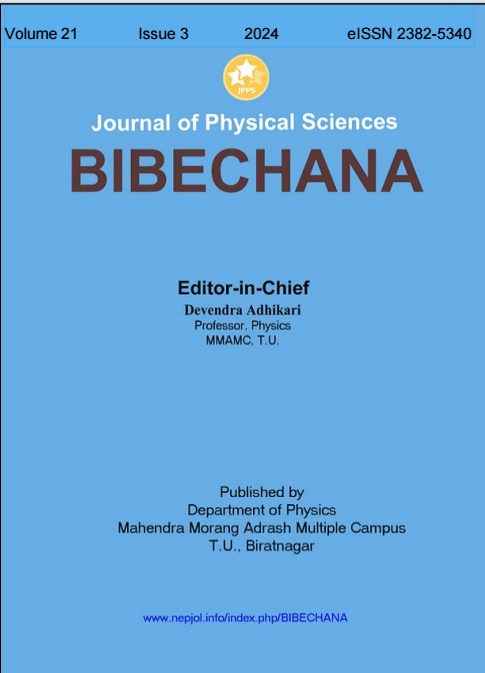Characterization of atmospheric circular dielectric barrier discharge via electrical and optical methods
DOI:
https://doi.org/10.3126/bibechana.v21i3.62034Keywords:
Boltzmann plot, electrical parameters, electron excitation temperature, Lissajous curve, rotational temperature, ,vibrational temperature.Abstract
This research work is concerned with the comprehensive study of the electrical and optical characterization of an atmospheric pressure circular dielectric barrier discharge (APCDBD) in natural air. The effect of airflow and input voltage on the power supply’s behavior has been investigated to keep the electrode gap constant. The energy and power dissipated during the discharge cycle are calculated by the Lissajous plot and the time average of the voltage and current curve. For the optical characterization of APCDBD, light emission during the plasma discharge is examined electron excitation temperature, rotational temperature, vibrational temperature, and plasma density have been computed. The Boltzmann plot method is used to estimate the electron excitation temperature and vibrational temperature. The rotational and also vibrational temperatures are calculated from online MassiveOES software. It is found that multiple filamentry micro discharge is produced increasing the airflow and input voltage of the power supply. Energy per cycle of the discharge is increased for increasing input voltage and vice-versa in airflow. The discrepancy in the calculation of energy dissipation from discharge between time-averaged and Lissajous’s plot method is estimated. However, the fluctuation is less in the Lissajous plot method and hence, the calculation of energy from the Lissajous plot method is more suitable for plasma discharge. The power consumption of the plasma reactor is found to be dependent on the input of the power supply. Electron excitation temperature and the rotational temperature of the discharge decrease with increasing the airflow in the discharge and increase with increasing input voltage. Therefore, by using the airflow in dielectric barrier discharge, we can move closer to the room temperature of atmospheric pressure plasma.
Downloads
Downloads
Published
How to Cite
Issue
Section
License
Copyright (c) 2024 The Author(s)

This work is licensed under a Creative Commons Attribution-NonCommercial 4.0 International License.
This license enables reusers to distribute, remix, adapt, and build upon the material in any medium or format for noncommercial purposes only, and only so long as attribution is given to the creator.




